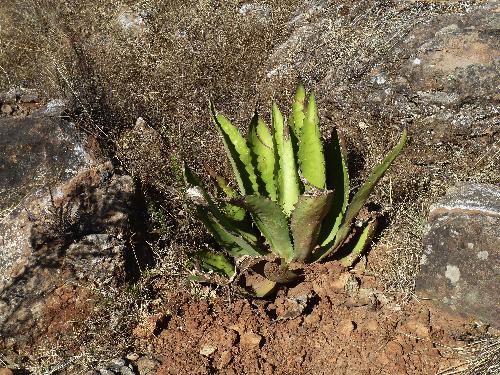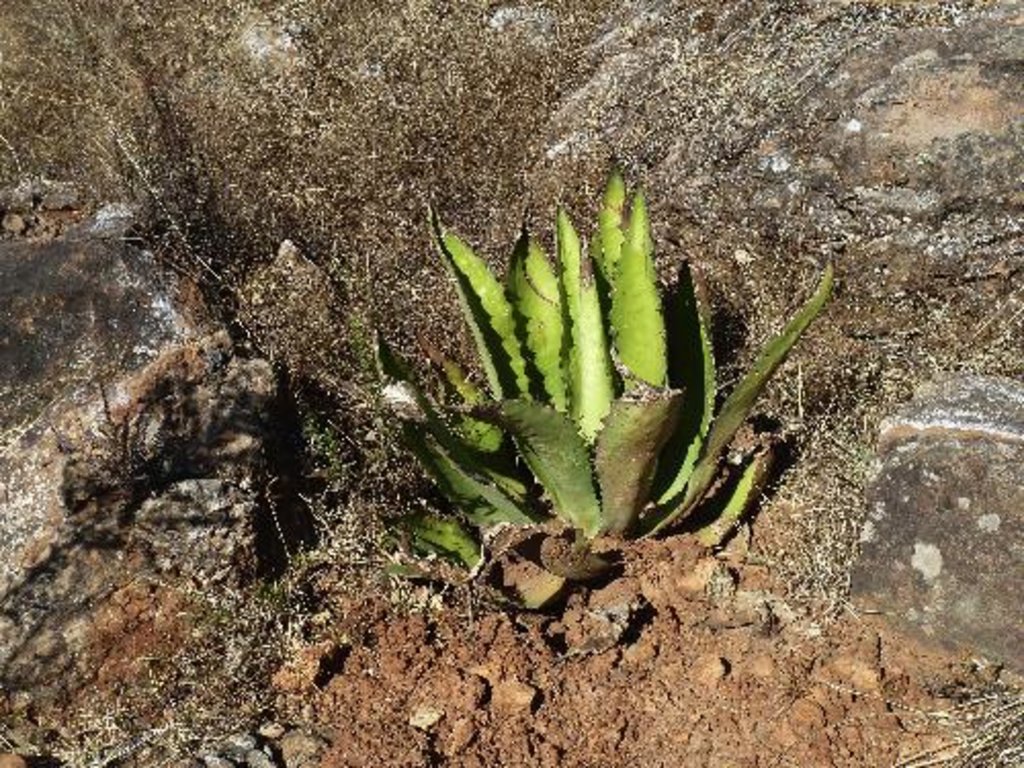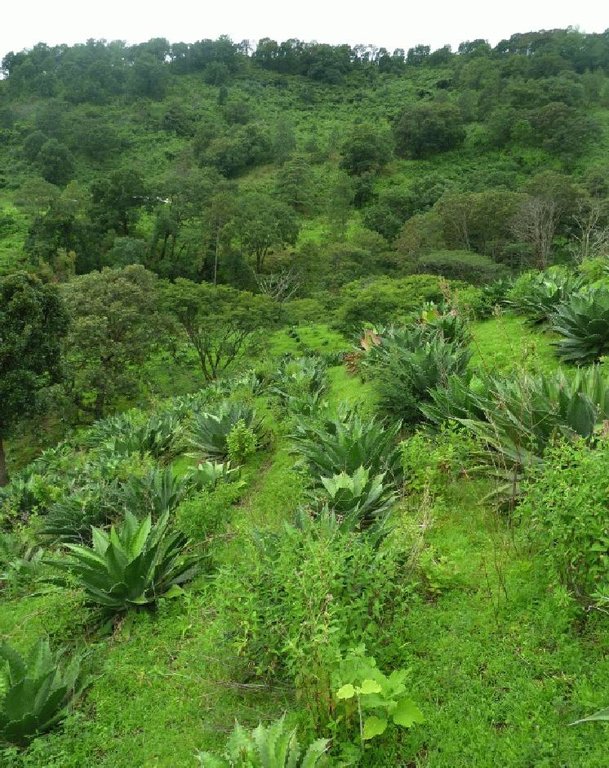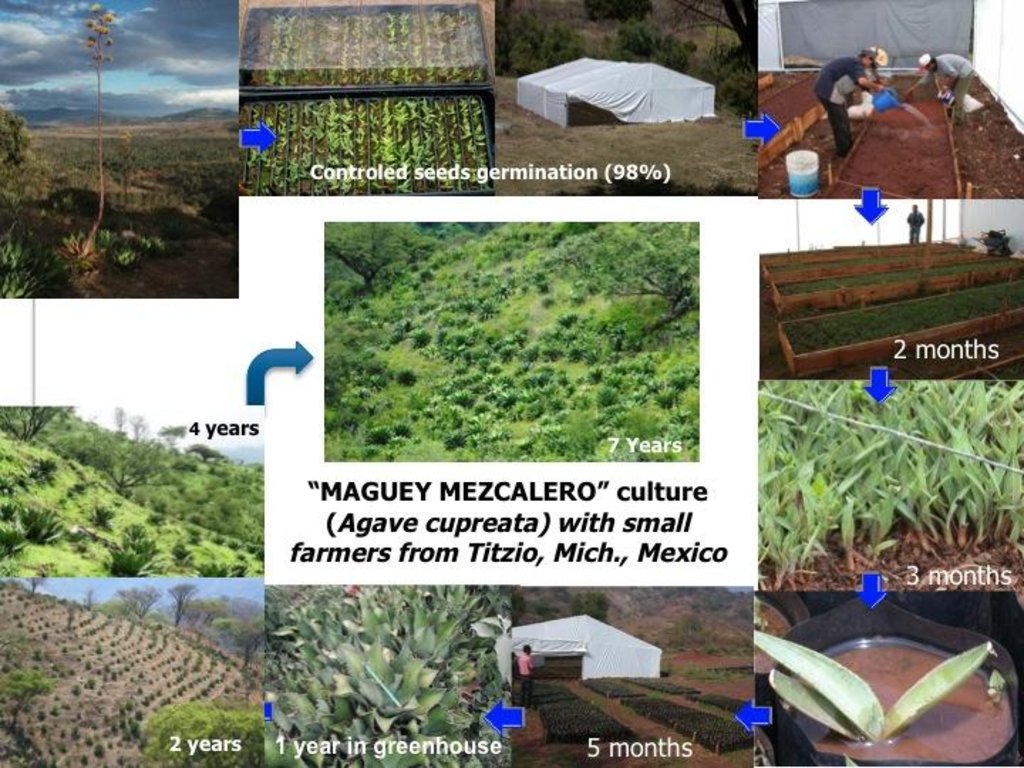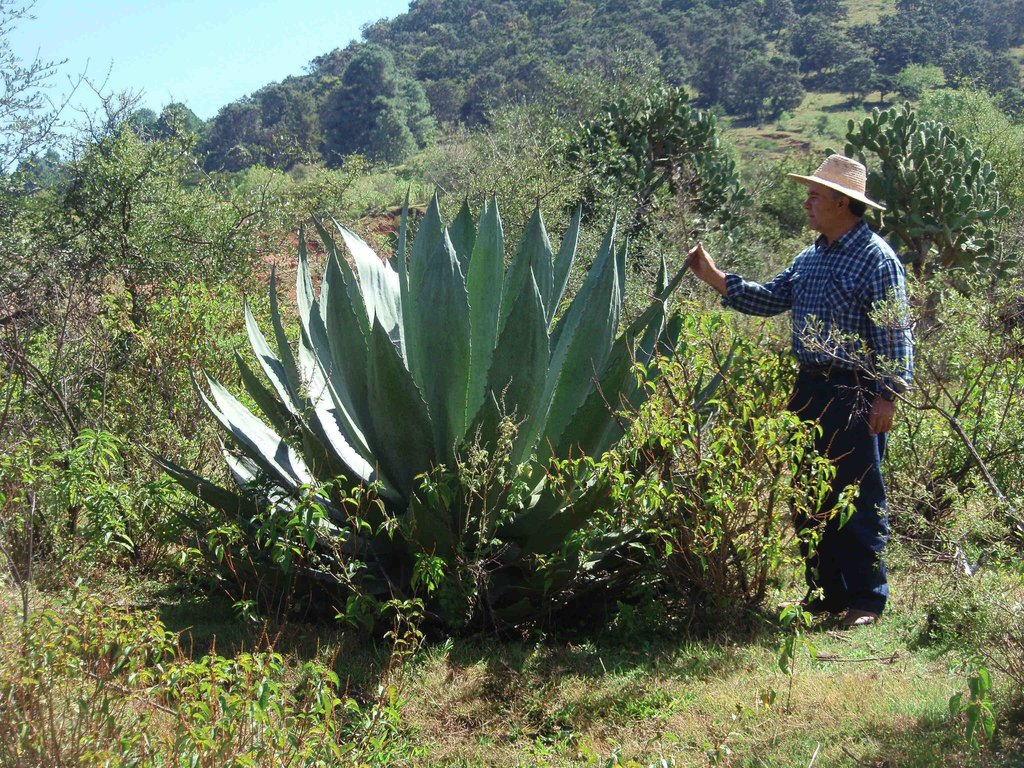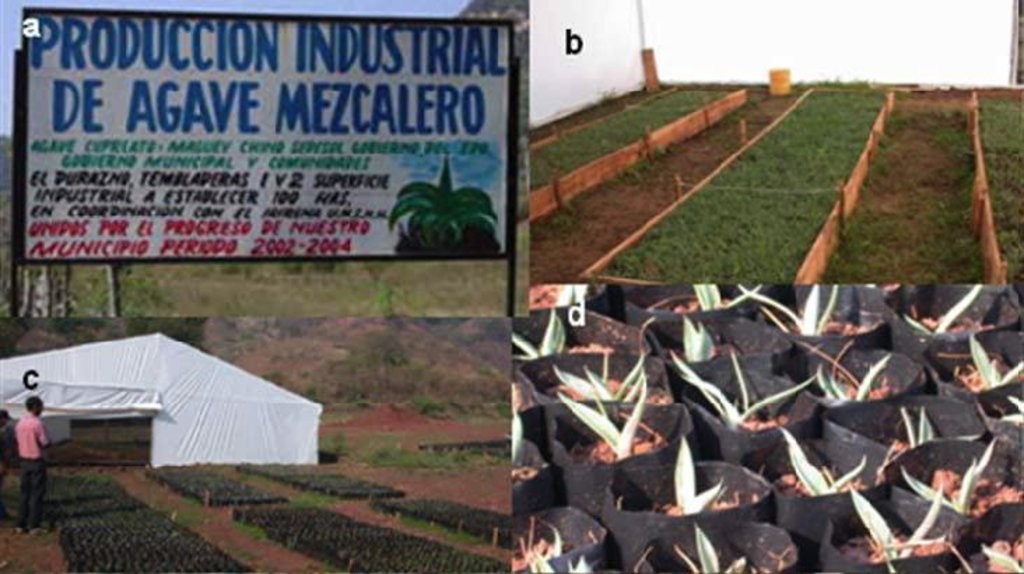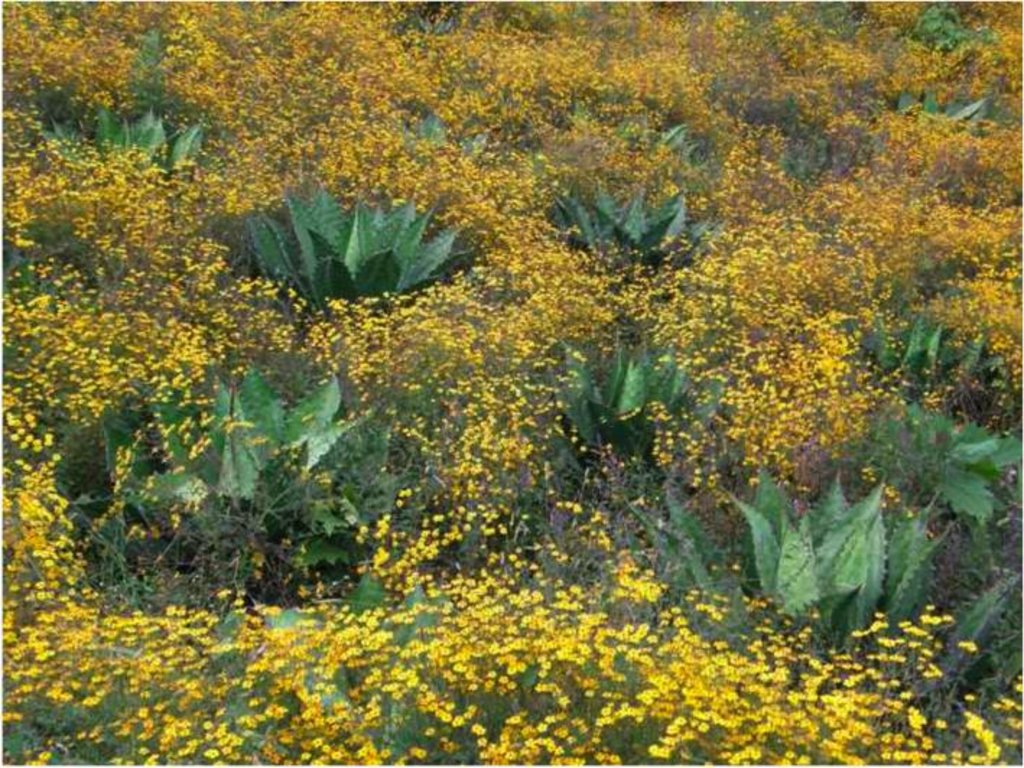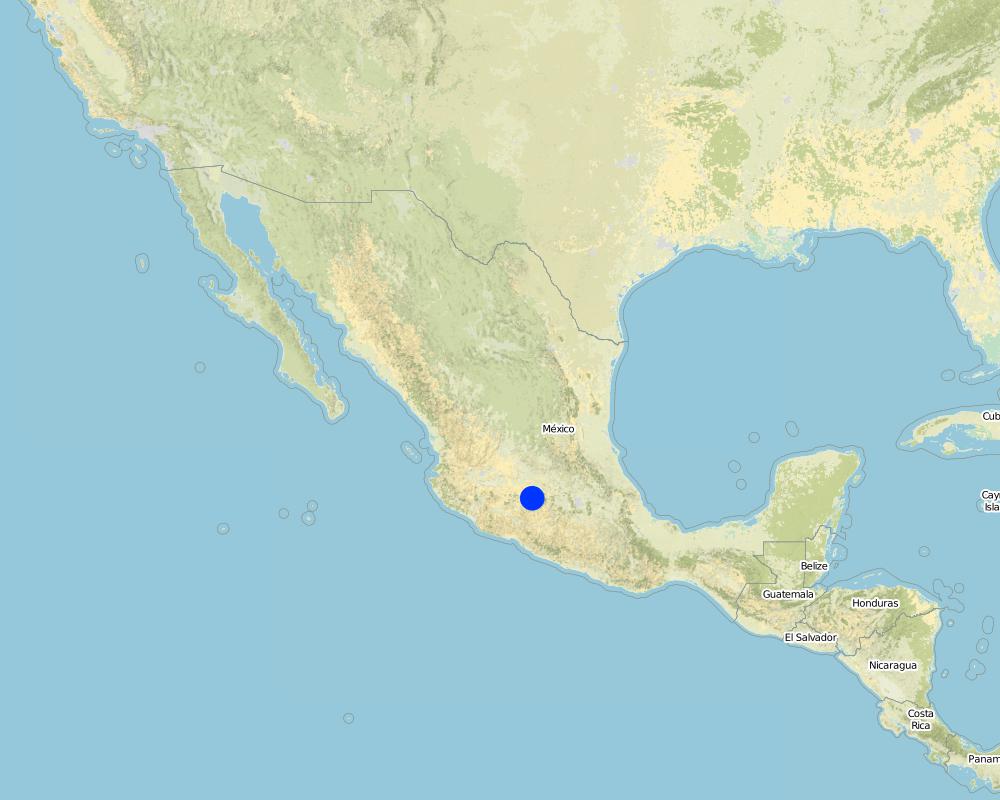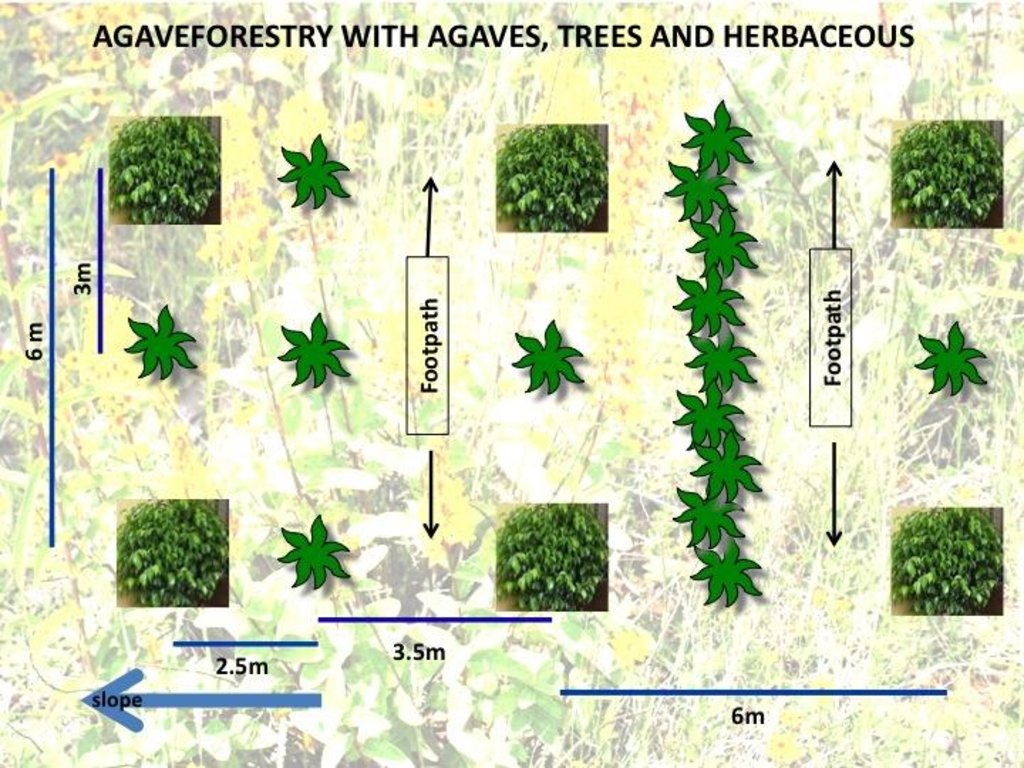Land reclamation by agave forestry with native species [Мексика]
- Создание:
- Обновить:
- Составитель: Christian Prat
- Редактор: –
- Рецензенты: David Streiff, Alexandra Gavilano
Recuperación de tierras degradadas por agaveforestería con especies locales de agaves, arboles y herbaceas (Spanish)
technologies_1114 - Мексика
Просмотреть разделы
Развернуть все Свернуть все1. Общая информация
1.2 Контактные данные специалистов и организаций, участвующих в описании и оценке Технологии
Специалист по УЗП:
Martínez Palacios Alejandro
Instituto de Investigaciones Agropecuarias y Forestales, Universidad Michoacana de San Nicolás de Hidalgo
Мексика
Специалист по УЗП:
Ríos Patrón Eduardo
Delegación de SEMARNAT en Michoacán, Unidad de Planeación y Política Ambiental
Мексика
Название проекта, содействовавшего документированию/оценке Технологии (если применимо)
DESIRE (EU-DES!RE)Название организации (-ий), содействовавших документированию/оценке Технологии (если применимо)
Instituto de Investigaciones Agropecuarias y Forestales (IIAF) - МексикаНазвание организации (-ий), содействовавших документированию/оценке Технологии (если применимо)
Institut de recherche pour le développement IRD (Institut de recherche pour le développement IRD) - ФранцияНазвание организации (-ий), содействовавших документированию/оценке Технологии (если применимо)
SECRETARÍA DE MEDIO AMBIENTE Y RECURSOS NATURALES (SECRETARÍA DE MEDIO AMBIENTE Y RECURSOS NATURALES) - МексикаНазвание организации (-ий), содействовавших документированию/оценке Технологии (если применимо)
Universidad Michoacana de San Nicolás de Hidalgo (UMSNH) - Мексика1.3 Условия, регламентирующие использование данных, собранных ВОКАТ
Составитель и ответственный(-ые) специалист(-ы) согласны с условиями, регламентирующими использование собранных ВОКАТ данных:
Да
1.5 Ссылка на Анкету (ы) по Подходам УЗП (документируется с использованием ВОКАТ)
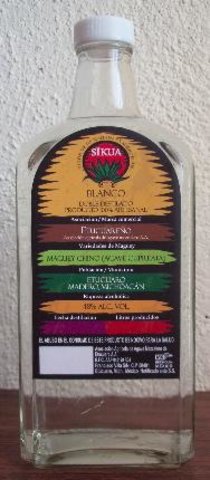
Participative actions for economic benefits of agave forestry [Мексика]
Land reclamation with local agave (to produce Mezcal) associated with trees, shrubs and grasses planted through participative actions for economic benefit.
- Составитель: Christian Prat
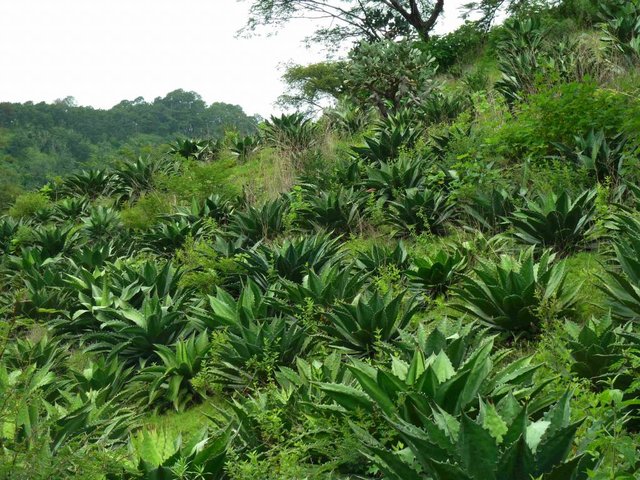
Land reclamation by agave forestry with native species [Мексика]
Land reclamation with local agave (to produce mezcal) associated wotj trees, shrubs and grasses planted through participative actions for economic benefit.
- Составитель: Christian Prat
2. Описание Технологии УЗП
2.1 Краткое описание Технологии
Определение Технологии:
Agave forestry land reclamation system with native agaves, trees, shrubs and grasses planted through participatory action for a sustainable production of mezcal and other products in order to generate high incomes for farmers.
2.2 Подробное описание Технологии
Описание:
Rehabilitation of degraded land is achieved using native agave (Agave inaequidens), trees and/or fruit trees, shrubs and grasses to create, over the medium-term (7-10 years), sustainable production of a traditional alcoholic drink (mezcal) made from agave and/or cosmetic and medicinal products, and/or fibres and/or fodder for cattle and/or wood. Between the agave plants, native vegetation is managed or planted for use as food, fodder and/or medicinal products. Depending on the slope and the level of land degradation, continuous planted rows of agave provide a ’green’ barrier that controls soil erosion and runoff.
Purpose of the Technology: The main purpose is to achieve sustainable land rehabilitation while generating a high income for the farmer. This allows reducing the amount of livestock and overgrazing, which is the main cause of soil erosion in this region. The production of mezcal gives local farmers high incomes. Trees, shrubs and grasses for medicinal uses, food, and fodder are complements of agave production and are processed mainly by women, while agave harvesting is a male activity. As it is very attractive financially, farmers stay in the communities instead of emigrating to cities or abroad. Biodiversity is preserved and increased using native plants (agaves, trees, shrubs, grasses). These plant associations are effective at controlling plant pests and diseases. Turning eroded into productive soil sequesters carbon and increases water availability as a result of the new soil cover.
Establishment / maintenance activities and inputs: Unlike most agave, Agave inaequidens reproduces from seed, which requires harvesting the seeds from native plants in the fields. One plant generates 80,000 seeds with a 90% success rate of germination, which is enough to cover 25 ha of agave forestry plantations set up to control soil erosion. After harvesting seeds from native agaves, trees and shrubs, seedlings and small plants are raised in a greenhouse and nursery managed by the owners and tenants of the land in the first year. At the beginning of the rainy season, these are planted in plots protected from cattle grazing for at least the first two years after planting. The harvesting activity for trees, shrubs and grasses is done annually, but for the agaves only once every 7 to 12 years depending on the degree of soil degradation. Some months before harvesting, the flower from the stem has to be cut. The leaves are then cut and left in the plot while the 50 kg heart of the agave (“piña”) is removed. Mezcal is produced from the heart and requires an average of three weeks and at least two men to process 25 agave plants (1.5 tonnes), which produces about 300 litres of mezcal.
Natural / human environment: Poverty levels in the area are medium to high and the income from agriculture accounts for only 10 to 20% of the total family budget. People, therefore, do not have time to install soil erosion protection systems in the fields. Cattle graze freely everywhere and the number of animals is increasing annually, which also increases soil erosion. Locals know how to produce mezcal, but they prefer to buy it from other people who take wild plants from their lands to process them. The proximity of the site to the Michoacán of Ocampo state capital and the recognition of the designation of origin for mezcal by the authorities will enhance its value for future production.
2.3 Фотографии, иллюстрирующие Технологию
2.5 Страна/ регион/ места, где применяется Технология, информация о которых собрана в данной Анкете
Страна:
Мексика
Административная единица (Район/Область):
Mexico/Michoacán state
Более точная привязка места:
Morelia municipality
Охарактеризуйте пространственное распространение Технологии :
- равномерно-однородное применение на определенной площади
Если точная область неизвестна, укажите приблизительную площадь:
- 0,1-1 км2
Пояснения:
630 km2 is the area of the Cointzio watershed. Untill now (2010), 10 ha have been managed with this technics and from 2011, 50 ha/year will be done (at least)
Map
×2.6 Сколько лет применяется данная Технология
Если год начала применения Технологии достоверно неизвестен, дайте примерную оценку:
- 10-50 лет назад
2.7 Внедрение Технологии
Пояснения (тип проекта и т.д.):
10 years ago, at Titzio, close to Cointzio basin, A. Martinez developped the culture of a wild native agave (Agave Cupreata) for alcohol production which was done traditionnaly for local consumming. We are following this project and objectives, but we are improving it for land remediation and soil erosion control too with a new species of native Agave (A. inaequidens)
3. Классификация Технологии УЗП
3.1 Основные цели и задачи реализации Технологии
- снижение или предотвращение деградации земель, восстановление нарушенных земель
- создание благоприятных экономических условий
3.2 Текущий(-ие) тип(-ы) землепользования на территории, где применяется Технология
Комбинированное землепользование в пределах одной и той же земельной единицы:
Да
Укажите сочетания типов землепользования (посевы / пастбища / деревья):
- Агро-лесо-пастбищное хозяйство

Пахотные угодья и плантации
- Многолетние (недревесные) культуры
Многолетние (недревесные) культуры - Уточните культуры:
- агава / сизаль
Число урожаев за год:
- 1
Поясните:
Longest growing period in days: 190; Longest growing period from month to month: June to November

Пастбищные угодья
Экстенсивный выпас:
- Полукочевое скотоводство

Леса/ лесистая местность
Продукции и услуги:
- Древесина
- Дрова
- Плоды и орехи
- Другие продукты леса
- Выпас/ ощипывание молодых побегов и листьев
- Природоохранные/ защитные
Пояснения:
Major land use problems (compiler’s opinion): Mainly overgrazing due to uncontrolled grazing by cattle.
Major land use problems (land users’ perception): Soil erosion by water due to the storms and improper land use.
Semi-nomadism / pastoralism: Yes
Forest products and services: timber, fuelwood, grazing / browsing, other forest products / uses (honey, medical, etc.), nature conservation / protection
Future (final) land use (after implementation of SLM Technology): Mixed: Mf: Agroforestry
Livestock density: 1-10 LU /km2
3.3 Изменилось ли использование земель в связи с внедрением Технологии?
Изменилось ли использование земель в связи с внедрением Технологии?
- Да (Пожалуйста, заполните нижеприведенные вопросы относительно использования земель до внедрения Технологии)

Пастбищные угодья
- Extensive grazing
3.4 Водоснабжение
Обеспеченность водой участков, где реализуется Технология :
- богарные земли
3.5 Категория УЗП, к которой относится Технология
- Улучшение почвенного/ растительного покрова
- мероприятия по влагозадержанию и снижению эрозии почв на склонах
- улучшение сортов растений/ пород животных
3.6 Мероприятия УЗП, выполняемые в рамках Технологии

Агрономические мероприятия
- A1: Растительный/ почвенный покров

Мероприятия с использованием растительности
- Р1: Древесный и кустарниковый покров

инженерные мероприятия
- И11: Другие

управленческие мероприятия
- У3: Размещение с учетом природных и социально-экономических условий
Пояснения:
Secondary measures: agronomic measures, management measures
Type of agronomic measures: better crop cover, mixed cropping / intercropping, contour planting / strip cropping, cover cropping, retaining more vegetation cover, breaking compacted topsoil, contour ridging, breaking compacted subsoil
Type of vegetative measures: aligned: -contour
3.7 Основные проблемы деградации земель, на решение которых направлена Технология

водная эрозия почв
- ВЭп: поверхностная эрозия/смыв верхних почвенных горизонтов
- ВЭл: овражная эрозия / оврагообразование

ухудшение физических свойств почв
- Фд: утрата био-продуктивных функций по другим причинам

биологическая деградация
- Бр: сокращение растительного покрова
- Бк: сокращение количества биомассы
- Бв: потеря природного разнообразия

деградация водных ресурсов
- Вуп: изменение объема поверхностного стока
Пояснения:
Secondary types of degradation addressed: Pu: loss of bio-productive function due to other activities, Bq: quantity / biomass decline, Hs: change in quantity of surface water
Main causes of degradation: soil management (System of one year culture/one year fallow with cattle), overgrazing (THE real cause of soil erosion here), poverty / wealth (Cattle is used as a "bank on 4 feet")
Secondary causes of degradation: crop management (annual, perennial, tree/shrub), deforestation / removal of natural vegetation (incl. forest fires), over-exploitation of vegetation for domestic use (Untill 30 years ago, some wood was used for carbon used for cooking), population pressure
3.8 Предотвращение и снижение деградации земель, или восстановление нарушенных земель
Укажите цель Технологии по отношению к деградации земель :
- восстановление/ реабилитация нарушенных земель
Пояснения:
Secondary goals: prevention of land degradation, mitigation / reduction of land degradation
4. Технические характеристики, мероприятия по практической реализации, вложения и стоимость
4.1 Технический рисунок, иллюстрирующий Технологию
Спецификация (пояснения к техническому рисунку):
Agave production is based on planting them with trees along the contour. Herbs are maintained / planted or sown between the plants. Depending on the slope, one or more dense lines of agaves (1 plant every 25 cm) is planted for control of soil erosion and runoff, including a lateral gradient to the gully which will evacuate the excessive runoff. Footpaths are planned for the maintenance of the plantation
Location: Michoacán. Mexico
Date: 2010
Technical knowledge required for field staff / advisors: low (low for reproduction, plantation and cultivation and middle for alcohol production)
Technical knowledge required for land users: low (low for reproduction, plantation and cultivation and middle for alcohol production)
Main technical functions: control of dispersed runoff: retain / trap, control of concentrated runoff: retain / trap, improvement of ground cover, improvement of surface structure (crusting, sealing), improvement of topsoil structure (compaction), improvement of subsoil structure (hardpan), increase of infiltration, sediment retention / trapping, sediment harvesting, increase of biomass (quantity), promotion of vegetation species and varieties (quality, eg palatable fodder)
Secondary technical functions: control of raindrop splash, control of dispersed runoff: impede / retard, control of concentrated runoff: impede / retard, control of concentrated runoff: drain / divert, reduction of slope angle, reduction of slope length, increase of surface roughness, stabilisation of soil (eg by tree roots against land slides), increase in organic matter, increase in nutrient availability (supply, recycling,…), increase / maintain water stored in soil, increase of groundwater level / recharge of groundwater, water harvesting / increase water supply, water spreading, improvement of water quality, buffering / filtering water, spatial arrangement and diversification of land use
Better crop cover
Material/ species: Agave inaequidens+native trees+herbaceous
Quantity/ density: 830/270
Remarks: Agaves/Trees per ha
Mixed cropping / intercropping
Material/ species: Agave inaequidens+native trees+herbaceous
Quantity/ density: 830/270
Remarks: Agaves/Trees per ha
Contour planting / strip cropping
Material/ species: Agave inaequidens+native trees+herbaceous
Quantity/ density: 830/270
Remarks: Agaves/Trees per ha
Cover cropping
Material/ species: Native trees+herbaceous
Agronomic measure: Herbaceous
Material/ species: Native herbaceous
Agronomic measure: Leafs from trees
Material/ species: Native trees
Quantity/ density: 270
Remarks: Trees per ha
Breaking compacted topsoil
Material/ species: Agave inaequidens+native trees+herbaceous
Quantity/ density: 830/270
Remarks: Agaves/Trees per ha
Contour ridging
Material/ species: Agave inaequidens+native trees+herbaceous
Quantity/ density: 830/270
Remarks: Agaves/Trees per ha
Breaking compacted subsoil
Material/ species: Agave inaequidens+native trees+herbaceous
Quantity/ density: 830/270
Remarks: Agaves/Trees per ha
Aligned: -contour
Vegetative material: C : perennial crops
Number of plants per (ha): 1200
Spacing between rows / strips / blocks (m): 30
Vertical interval within rows / strips / blocks (m): 0,25
Width within rows / strips / blocks (m): 1
Aligned: -along boundary
Vegetative material: O : other
Vegetative measure: Vegetative material: F : fruit trees / shrubs
Perennial crops species: Agave inaequidens (mature between 7 to 14 years)
Slope (which determines the spacing indicated above): 30%
Gradient along the rows / strips: 30%
Vegetation is used for stabilisation of structures.
Layout change according to natural and human environment: Natives plants are used, planted according to the slopes and the rest of vegetation still existing
Автор:
Alejandro Martinez, apalacios56@gmail.com
4.2 Общая информация по необходимым вложениям и стоимости
Уточните, как рассчитывались затраты и вложения:
- на площадь, где применяется Технология
Укажите размер и единицу площади:
100 ha
другая/ национальная валюта (название):
mexican pesos
Если это необходимо, укажите обменный курс от доллара США к местной валюте (например, 1 доллар США = 79,9 бразильского реала): 1 доллар США =:
13,0
Укажите среднюю дневную заработную плату наемных работников:
160
4.3 Мероприятия, необходимые для начала реализации
| Деятельность | Время (сессия) | |
|---|---|---|
| 1. | Selection and collect Agave and tree seeds | 1 week |
| 2. | Building of greenhouses incl. soil and organic matter | 1 month |
| 3. | Fencing of greenhouses with barbed wire, poles and nails (0.5 ha | |
| 4. | Seeding & maintaining in greenhouses | 3 monthes |
| 5. | Installation of a nursery for agaves and trees and transplantation of seedlings in plastic bags | 2 weeks |
| 6. | Plant care and maintaining in nursery (9 months) | 9 monthes |
| 7. | Transportation of plants in plastic bags | |
| 8. | Plantation of plants (agaves and trees) |
4.4 Вложения и затраты, необходимые для начала реализации
| Опишите затраты | Единица | Количество | Затраты на единицу | Общая стоимость на единицу | % затрат, оплаченных землепользователями | |
|---|---|---|---|---|---|---|
| Оплата труда | Building of greenhouses | persons/day | 21,0 | 523,8095 | 11000,0 | |
| Оплата труда | Seeding & maintaining in greenhouses | persons/3 months | 2,0 | 5000,0 | 10000,0 | |
| Оплата труда | Installation of a nursery for agaves and trees | persons/day | 14,0 | 1071,4285 | 15000,0 | |
| Оплата труда | Plant care and maintaining in nursery | persons/9months | 2,0 | 15000,0 | 30000,0 | |
| Посадочный материал | Selection and collect Agave and tree seeds | plants | 5,0 | 100,0 | 500,0 | |
| Удобрения и ядохимикаты | Materials for plant care | months | 9,0 | 2777,7777777 | 25000,0 | |
| Строительные материалы | Materials for greenhouse | trees | 60000,0 | 0,056666666 | 3400,0 | |
| Строительные материалы | Materials for greenhouse | agave | 200000,0 | 0,035 | 7000,0 | |
| Строительные материалы | Materials for fences | m | 1500,0 | 2,4 | 3600,0 | |
| Строительные материалы | Materials for nurserys | trees | 60000,0 | 1,5 | 90000,0 | |
| Строительные материалы | Materials for nurserys | agaves | 200000,0 | 0,2 | 40000,0 | |
| Общая стоимость запуска Технологии | 235500,0 | |||||
| Общие затраты на создание Технологии в долларах США | 18115,38 | |||||
Пояснения:
Duration of establishment phase: 12 month(s)
4.5 Поддержание/ текущее обслуживание
| Деятельность | Сроки/ повторяемость проведения | |
|---|---|---|
| 1. | Cleaning around plants to give them space the first 3 years (For 1 person 10 days) | 1 time/year |
| 2. | Cutting the scape before the harvest (For 1 person 15 days) | 1 time in agave life (between 7-14 years) |
| 3. | Weeding around plants to give them space during the first 3 years (10 person days) | 1 time/year |
| 4. | Cutting the stalk before the harvest (15 person days) | 1 Agavelife time (7 to 14 years old) |
| 5. | Replanting of agaves after 7 to 14 years (restarting of a new cycle of production, see establishment activities) |
4.6 Стоимость поддержания/ текущего обслуживания ( в год)
| Опишите затраты | Единица | Количество | Затраты на единицу | Общая стоимость на единицу | % затрат, оплаченных землепользователями | |
|---|---|---|---|---|---|---|
| Оплата труда | Weeding around plants | persons/day | 10,0 | 160,0 | 1600,0 | 10,0 |
| Оплата труда | Cutting the stalk before the harvest | persons/day | 15,0 | 150,0 | 2250,0 | 10,0 |
| Общая стоимость поддержания Технологии | 3850,0 | |||||
| Общие затраты на поддержание Технологии в долларах США | 296,15 | |||||
Пояснения:
Calculations are for the plantation of 200,000 plants (agaves and trees) which correspond to the numbers of plants for 100 ha in the agave forestry example presented here. The main portion of these plants is planted by the community on the own land; the rest is given or sold to other communities or private people. The lifetime of the greenhouse, nursery and fencing installations are around 10 years.
4.7 Наиболее значимые факторы, влияющие на стоимость затрат
Опишите наиболее значимые факторы, влияющие на стоимость затрат:
The most important factors determining the costs are: 1) the materials to build a greenhouse and the personal to take care of young plants; 2) the difficulties to make holes in the indurated soils, which takes time and efforts; and 3) the distance between the nursery and the field requires time and efforts (truck carrying the plants).
5. Природные и социально-экономические условия
5.1 Климат
Среднегодовое количество осадков
- < 250 мм
- 251-500 мм
- 501-750 мм
- 751-1000 мм
- 1001-1500 мм
- 1501-2000 мм
- 2001-3000 мм
- 3001-4000 мм
- > 4000 мм
Пояснения/ комментарии по осадкам:
Rainy season from june to october
Агроклиматическая зона
- полузасушливая
Thermal climate class: subtropics
Thermal climate class: temperate
5.2 Рельеф
Склоны (преобладающие):
- пологие (0-2%)
- покатые (3-5%)
- покато-крутые (6-10%)
- крутые (11-15%)
- очень крутые (16-30%)
- чрезвычайно крутые (31-60%)
- обрывистые (>60%)
Формы рельефа:
- плато/ равнины
- гребни хребтов/холмов
- склоны гор
- склоны холмов
- подножья
- днища долин
Зона высотной поясности:
- 0-100 м над уровнем моря
- 101-500 м н.у.м.
- 501-1000 м н.у.м.
- 1001-1500 м н.у.м.
- 1501-2000 м н.у.м.
- 2001-2500 м н.у.м.
- 2501-3000 м н.у.м.
- 3001-4000 м н.у.м.
- > 4 тыс. м н.у.м.
Укажите, приурочено ли применение Технологии к специфическим условиям:
- не имеет значения
Комментарии и дополнительные сведения по условиям рельефа/ топографии :
Slopes on average: Also steep, very steep and moderate
Altitudinal zone (2000-2500 m a.s.l.) : The Agave inaequidens grows is this conditions but other spieces of Agaves grow in other agroclimatic conditions
5.3 Почвы
Средняя мощность почв:
- поверхностные (0-20 см)
- неглубокие (21-50 см)
- умеренно глубокие (51-80 см)
- глубокие (81-120 см)
- очень глубокие (> 120 см)
Гранулометрический состав (верхнего горизонта):
- средние фракции (суглинистый, супесчаный)
- тонкодисперсный/ тяжёлый (глинистый)
Содержание органического вещества в верхнем горизонте:
- среднее (1-3%)
- низкое (< 1%)
Если возможно, приложите полное описание почв или укажите доступную информацию, например тип почв, рH/ кислотность почв, ёмкость катионного обмена, содержание азота, содержание солей и т.д.
Soil depth on average: For Agaves and herbaceous no problems, for trees much more difficult
Soil texture (topsoil): For Agaves, trees and herbaceous no problems
Soil fertility is very low - medium: For Agaves, trees and herbaceous no problems
Soil drainage / infiltration is medium - poor: For Agaves and herbaceous no problems, but some difficulties for some tree species
Soil water storage capacity is very low - medium: For Agaves and herbaceous no problems, but some difficulties for some tree species
5.4 Доступность и качество воды
Уровень грунтовых вод:
5-50 м
Доступность поверхностных вод:
средняя
Качество воды (без обработки):
исключительно для сельскохозяйственного использования (орошение)
Комментарии и дополнительная информация по качеству и количеству воды:
Ground water table: Also > 50 m and for Agaves, trees and herbaceous no problems
Availability of surface water: Also poor/ none and for Agaves and herbaceous no problems, but some difficulties for some tree species
Water quality (untreated): Also unusable
5.5 Биоразнообразие
Видовое разнообразие:
- высокое
Комментарии и дополнительная информация по биоразнообразию:
Use of native species
5.6 Характеристика землепользователей, применяющих Технологию
Рыночная ориентация производства:
- смешанный (натуральный / коммерческий)
Доходы из других источников:
- > 50% всех доходов
Индивидуальное или коллективное хозяйство:
- группа/ община
Уровень механизации:
- ручной труд
- механизировано/ есть автотранспорт
Пол:
- женщины
- мужчины
Укажите другие важные характеристики землепользователей:
Land users applying the Technology are mainly common / average land users
Difference in the involvement of women and men: Men for hard works: digging holes during the plantation and carrying plants during the harvest
Women and men, do the rest of the activities
Population density: 10-50 persons/km2
Annual population growth: 1% - 2%
Relative level of wealth: average, poor, very poor
34% of the land users are average wealthy.
33% of the land users are poor.
33% of the land users are poor.
Off-farm income specification: off farm incomes represent between 80 to 90% of the annual incomes! This money is obtain through an "external" job, business, trade, or by money send by family from the USA
Market orientation of production system: 90% commercial but some plants (fruit trees, some herbaceus) can be consummed.
Level of mechanization: Manual labour for seed collect, greenhouse, digging holes, plantation, cleaning and harvesting and in some case, tractor can pass to make sub soiling for the plantation of Agave lines to control soil erosion.
5.7 Средняя площадь земель, используемых землепользователями с применением Технологии
- < 0,5 га
- 0,5-1 га
- 1-2 га
- 2-5 га
- 5-15 га
- 15-50 га
- 50-100 га
- 100-500 га
- 500-1000 га
- 1000-10000 га
- > 10000 га
Считается ли это мелким, средним или крупным хозяйством (по местным масштабам)?
- мелкое
Пояснения:
Also 15-50 ha
5.8 Собственность на землю, права на земле- и водопользование
Землевладелец:
- общинная/ поселковая
- индивидуальная, оформленная в собственность
- ejido
Право землепользования:
- общинное (контролируемое)
- индивидуальное
- ejido
Право водопользования:
- общинное (контролируемое)
- индивидуальное
- ejido
Пояснения:
"ejido" is the community organisation in Mexico: land belongs to the state but it is managed by the community. Some areas can be used by everybody; others are assigned to the land user families.
5.9 Доступ к базовым услугам и инфраструктуре
медицинское обслуживание:
- плохой
- средний
- хорошая
образование:
- плохой
- средний
- хорошая
технические консультации:
- плохой
- средний
- хорошая
занятость (вне хозяйства):
- плохой
- средний
- хорошая
рынки:
- плохой
- средний
- хорошая
электроснабжение:
- плохой
- средний
- хорошая
транспорт и дорожная сеть:
- плохой
- средний
- хорошая
водоснабжение и канализация:
- плохой
- средний
- хорошая
финансовые услуги:
- плохой
- средний
- хорошая
6. Воздействия и заключительные положения
6.1 Влияние Технологии УЗП в пределах территории ее применения
Социально-экономическое воздействие
Продуктивность
производство сельскозяйственных культур
производство кормов
качество кормов
производство продуктов животноводства
Комментарий/ пояснения:
Reduction number of animals but improvement of meat production
производство древесины
разнообразие продукции
площадь, используемая для производства продукции
Доходы и затраты
доходы хозяйства
разнообразие источников дохода
Социальное и культурное воздействие
продовольственная безопасность/ самообеспечение
состояние здоровья
Комментарий/ пояснения:
Directly by plants , indirectly with the money earned, it is possible to buy medecinal products.
If producers sell their alcohol production abroad, no problems, if not problems!
культурные возможности
возможности отдыха и рекреации
знания в области УЗП/ деградации земель
Комментарий/ пояснения:
Huge beneficts can create great conflicts!
смягчение конфликтов
положение социально и экономически уязвимых групп населения
impact on the community due to the huge beneficts
Комментарий/ пояснения:
It can be positive as well as negative (may induce corruption, violence)
livelihood and human well-being
Комментарий/ пояснения:
The production of alcohol beverage (certified Mescal) from agaves, and/or in medicinal products, will generate very high Incomes for stakeholders. Life will change drastically. This allows the farmer's sons to stay in the community and work in the fields.
Экологическое воздействие
Водный цикл/ поверхностный сток
сбор воды/ водоудержание
поверхностный сток
уровень грунтовых/ подземных вод
Почвы
влажность почв
почвенный покров
утрата почв
образование корки на поверхности почв/ запечатывание
уплотнение почв
круговорот/ восполнение питательных веществ
Биоразнообразие: растительность, животный мир
биомасса/ содержание углерода в надземной биомассе
разнообразие флоры
разнообразие фауны
разнообразие местообитаний
Климат и снижение риска стихийных бедствий
риск пожаров
скорость ветра
6.2 Влияние Технологии за пределами территории ее применения
доступность воды
надежность и постоянство водотоков
подтопление ниже по течению
отложение наносов ниже по течению
загрязнение подземных/ речных вод
буферная/ фильтрационная способность
ущерб прилегающим полям
ущерб объектам инфраструктуры общего/ частного пользования
biodiversity
6.3 Подверженность и чувствительность Технологии УЗП к постепенным изменениям климата и экстремальным погодным явлениям/ стихийным бедствиям, связанным с изменением климата (в понимании землепользователей)
Постепенное изменение климата
Постепенное изменение климата
| Сезон | увеличение или уменьшение | Насколько успешно Технология справляется с этим? | |
|---|---|---|---|
| среднегодовые температуры | увеличилось | хорошо |
Экстремальные явления, связанные с изменением климата (стихийные бедствия)
Погодные стихийные бедствия
| Насколько успешно Технология справляется с этим? | |
|---|---|
| местные ливневые дожди | хорошо |
| местные ураганы | хорошо |
Стихийные бедствия климатического характера
| Насколько успешно Технология справляется с этим? | |
|---|---|
| засухи | хорошо |
Гидрологические стихийные бедствия
| Насколько успешно Технология справляется с этим? | |
|---|---|
| регулярные наводнения (выход рек из берегов) | хорошо |
Другие воздействия, связанные с изменением климата
Другие воздействия, связанные с изменением климата
| Насколько успешно Технология справляется с этим? | |
|---|---|
| сокращение вегетационного периода | хорошо |
6.4 Анализ эффективности затрат
Насколько получаемый результат сопоставим с первоначальными вложениями (с точки зрения землепользователей)?
Эффективность затрат в краткосрочной перспективе:
отрицательно
Эффективность затрат в долгосрочной перспективе:
очень позитивное
Насколько получаемый результат сопоставим с текущими расходами по поддержанию технологии (с точки зрения землепользователей)?
Эффективность затрат в краткосрочной перспективе:
отрицательно
Эффективность затрат в долгосрочной перспективе:
очень позитивное
Пояснения:
That is why, state institutions fund the installations of this system meanwhile the production did not start. After that, benefits generated will be enough to motivate people to increase by themselves, the surface to remediate, without economical helps.
6.5 Внедрение Технологии
- 1-10%
Если возможно, дайте количественную характеристику (число домохозяйств и/или площадь применения):
50 households covering 10 percent of the stated area
Среди применяющих Технологию землепользователей, какова доля лиц, применяющих её по собственной инициативе, т.е. без какого-либо материального стимулирования со стороны?
- 0-10%
Пояснения:
50 land user families have adopted the Technology with external material support
Comments on acceptance with external material support: The program just start in 2010, so it is too early to reduce the experience at few hectares!
As the land users belongs to the same comunity ("ejido"), formally, all the inhabitants are involved in some way by this experience
Comments on spontaneous adoption: As the program just started in 2010, it is impossible to have an exact overview of the results now (end of 2011). As the land users belong to the same community ("ejido"), formally, all the inhabitants are involved in some way
There is a strong trend towards spontaneous adoption of the Technology
Comments on adoption trend: It is too early to identify an adoption trend.
6.7 Сильные стороны/ преимущества/ возможности Технологии
| Сильные стороны/ преимущества/ возможности по мнению составителя или других ключевых специалистов |
|---|
|
Remediation of degraded land turning it to a sustainable production generating very high incomes in the medium term How can they be sustained / enhanced? life will change drastically and not necessarily for the better. Transparency and communication regarding benefits and land use are necessary. |
|
Project done in a participative way where different kind of stakeholders are involved: administrations, politics, scientists and people. How can they be sustained / enhanced? Maintain workshops dynamic between stakeholders, present results to other authorities and forum |
|
Low-cost project but need to be funded and supported with technical and institutional advice to initiate the first cycle of the project. How can they be sustained / enhanced? Farmers can start to produce their mezcal from the wild agaves to sell them to wholesalers and use this money to pay for the project. |
|
As a result of the economical benefits, young people will stay in the communities. How can they be sustained / enhanced? Involve the young to guarantee the future: develop the marketing, the diversification of the products, the quality of production, etc. |
|
It will hopefully reduce the number of cattle, which are the main cause of soil erosion, as farmers lose interest in cattle raising. How can they be sustained / enhanced? Authorities need to monitor this and inform the farmers about the ecological impact of too much free cattle grazing. |
6.8 Слабые стороны/ недостатки/ риски Технологии и пути их преодоления
| Слабые стороны/ недостатки/ риски по мнению составителя или ответственных специалистов | Возможные пути их преодоления/снижения? |
|---|---|
| Obligation to find external funds to pay the first steps of the system (greenhouse, planting, etc.) due to the lack of incomes amongst farmers. | Involve all stakeholders in the project |
| Be sure that alcohol production will not be consummed in excess in the community | Control of the volume of the production, and the sufficiently high selling price should avoid "losing" the production at local scale |
| Risk that the benefits will be captured by few people | Transparency and stakeholder communication in accounting for the benefits |
| Marketing and selling the products | Authorities help the farmers to contact sellers. The formation of communities of producers, leading to products conforming to regulations that maintain good quality and provide certification. |
| Owing to the high incomes, life will change drastically and not necessarily for the better. |
7. Справочные материалы и ссылки
7.1 Методы сбора/ источники информации
7.2 Ссылки на опубликованные материалы
Название, автор, год публикации, ISBN:
Colunga-García Marín P., D. Zizumbo-Villareal, J.T. Martínez. 2007. Tradiciones en el aprovechamiento de los agaves mexicanos: una aportación a la protección legal y conservación de su diversidad biológica y cultural. In: En lo Ancestral hay Futuro: del Tequila, los Mezcales y otros Agaves. P. Colunga-GarcíaMarín, L. Eguiarte, A. Larqué, D. Zizumbo-Villarreal (eds). CICY-CONACYT-CONABIO-SEMARNAT-INE. México D.F., pp. 85-112.
7.3 Ссылки на соответствующую онлайн-информацию
Название/ описание:
DESIRE project Mexico partner (IRD 22)
Адрес в сети Интернет:
http://www.desire-project.eu/
Ссылки и модули
Развернуть все Свернуть всеСсылки

Participative actions for economic benefits of agave forestry [Мексика]
Land reclamation with local agave (to produce Mezcal) associated with trees, shrubs and grasses planted through participative actions for economic benefit.
- Составитель: Christian Prat

Land reclamation by agave forestry with native species [Мексика]
Land reclamation with local agave (to produce mezcal) associated wotj trees, shrubs and grasses planted through participative actions for economic benefit.
- Составитель: Christian Prat
Модули
Нет модулей


